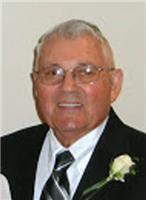







Company E - 137th Infantry Regiment

Thomas Lloyd Humber was born on September 29, 1922, to Thomas Bailey Humber and Mary Elizabeth Ballinger Humber. He farmed with his family in Fayette County, Alabama and graduated from Fayette County High School in 1941. He worked in Birmingham, AL, at Lewis Hardware selling barbed wire for a few months before moving to Memphis, TN to work as a shipping clerk at Sears and Roebuck. He registered for the draft on June 30, 1942, and enlisted in the United States Army on January 9, 1943, at Fort McClellan, Alabama, as a Private. The camps he trained at were: Fort McClellan, Alabama; Fort McPherson, Georgia; San Luis Obispo, California; Camp Rucker, Alabama; Camp Butler, North Carolina; and Camp Kilmer, New Jersey. On May 12, 1944, Lloyd departed for England by ship and arrived on the south shore of England on May 24, 1944.
Lloyd served in a light machine gun squad (30 caliber) in Company E of the 137th Infantry Regiment of the 35th Infantry Division. He left England for the beachheads of France in June 1944, and waded ashore at Omaha Beach on July 8, 1944 from an LST landing craft carrying 40 pounds of ammunition. They advanced about 1.5 miles to the front line. He then spent the night in a fox hole. The next morning, his Captain had them push off through an open field into a hollow. The Germans opened up with guns, mortars, and shells with no remorse. About half of his company was killed in the first push. That night they pulled the troops back to higher ground so they could get replacements for ones wounded or killed.
His regiment faced difficult fighting in the Normandy hedgerows north of St. Lo, France. On the beach, the 35th Division fought with the 12th Army Group under the command of General Omar Bradley. While fighting on the front lines in France, Lloyd was promoted to Staff Sergeant. When they finally got out of the hedgerows of Normandy, his Division joined with the 3rd Army under the leadership of General George S. Patton.
Lloyd said that on a typical day they would push off in an attack. They didn’t know what was in front of them. If they ran into the enemy, they had to start digging fox holes in order to keep from getting killed. They just kept pushing forward, surviving on K-rations. The K-rations were better than the C-rations, but they were supposed to be heated. He said that the worst parts of World War II were digging fox holes, being on guard duty at night, seeing your friends get killed, and being afraid that you would get killed.
The Division beat off 12 German counterattacks at Emelie before entering St. Lo on July 18th. After securing the St. Lo area, the Division took part in the offensive action southwest of St. Lo, pushing the Germans across the Vire, August 2, and breaking out of the Cotentin Peninsula. While en route to an assembly area, the Division was “flagged off the road,” to secure the Mortain-Avranches corridor and to rescue the 30th Division’s “Lost Battalion,” August 7-13, 1944. Then racing across France through Orleans and Sens, the Division attacked across the Moselle River near Nancy, France, where Lloyd was wounded in action. That night they were placing their boat in the water when a mortar casing slid and alerted the Germans who opened fire on them with anti-aircraft guns.
After recuperating from his injury, he rejoined the 137th Infantry Regiment on October 1, 1944. At that time, they were engaged in heavy fighting in the Gremecey Forest near Nancy, France. He fought with the Regiment as they continued their advance eastward toward the German border, taking Sarreguemines and crossing the Saar, December 8th.(1) By mid-December 1944, they had crossed into Germany. They were then pulled out of the front line and sent to Metz, France on December 19, 1944, to recuperate and reorganize over Christmas. Lloyd said the turkey dinner they had that Christmas was the best he had in his whole life.
But their rest didn’t last long. The day after Christmas they were on their way to the Ardennes to fight in the Battle of the Bulge. Lloyd was wounded in his right wrist by machine gun fire on January 4, 1945, in the vicinity of Villers-La-Bonne-Eau, about 5-6 miles south of Bastogne, Belgium. He was evacuated to England for treatment. He was discharged from the hospital and returned to duty in May 1945. Since the war in Europe had ended on May 7, 1944 (VE Day), he was sent to the Calas Staging Area near Marseilles, France, to wait for reassignment. At the time, troops and equipment were being loaded for transport to the Pacific for the planned invasion of Japan. The dropping of the atomic bombs in August 1945, however, negated the need for more troops. Since he had preference points for wounds and time served in combat, he was sent home and honorably discharged from Fort McPherson, Georgia, on October 8, 1945.
For his service during WWII, Lloyd received two Purple Hearts, the Combat Infantryman Badge, two Valor for Service medals, the European Theatre of Operations Ribbon with one battle star, and three gold hash marks for years of service.
fter his safe return home in October 1945, Lloyd married Arlene Black on January 26, 1946, at his parents’ home. They had five children and were married for almost 70 years. He worked for the U.S. Post Office for 31 years and continued to farm. He lived to be 93 years old.
(1) - On December 9, 1944, Lloyd wrote a letter home to his brother-in-law, Stacy Hocutt, about capturing German soldiers with his entrenching tool/shovel. In the fall of 2021, his grandson, David Fulmer, found the 1944 shovel in Lloyd’s workshop.

Somewhere in France
Saturday Evening, Dec 9, 1944
Hello Stacy and all:
I will write you a few lines this cold misty afternoon. I hope everyone is well. I am as well as could be in such condition.
Stacy, I will write you a few lines about the little deal I had with four Jerries. The wind was whistling around the corner very fast at night, blowing toward the enemy positions.
We were all in bed except the guards, as usual, holding our breath for fear we would have to go on outpost. Here comes the runner saying to get the machine gun section ready immediately. We are going to guard a bridge to keep the enemy from blowing it up, to form a tank trap.
Near the bridge was a knocked out Jerry tank and also there was a mortar in working order. We set up the gun close to the spot we are to guard, in fact, too close. Any way, the other boys dug a small hole and lay down to catch a little shut-eye.
Meanwhile I was digging the hole for the gun and watching for any one who might try slipping through the lines.
I looked up and to my surprise I saw four men moving slowly in back or to the side of me. At first I thought them to be our own men. But with a close look and with the light of a hay stack afire in the background I could tell they were Jerries. My pistol was at the other end of the hole, in my belt. The only thing I had on me was a shovel in my hands. I halted the four unknown men and immediately gave the password. There was no answer, so I hollered “hands up.” Nothing happened, and I yelled a little louder. By this time the two in the rear had turned around and fled. But I was lucky enough to get two of them to stay where they were.

One dropped his gun. The other had a pistol and a concussion grenade in his belt.
When the one dropped his I called my comrades who were awakened by this time. One of them held his rifle on them. I threw my shovel (6-shooter) down on the ground and stripped them down. The boys often kid me about my shovel, or ask me “Where is your shovel?”
I didn’t feel one bit good but was afraid to turn to get my pistol, because I knew they would run off then, so I just stuck out my shovel handle as if it were a gun.
I also have a souvenir from one of them and a friend has one also. He helped me search them.
Stacy, they had started there to get the mortar they had left in the rapid advance of our tanks and infantry. But they threw plenty of mortar shells on us the next morning. But I moved the mortar and you can bet they did not use it.
I marched the two Germans to the Company C.P. that night so we would not have to bother with them.
Hello to all. I hope to see you some day soon. Your brother-in-law,
Thomas LL. Humber
